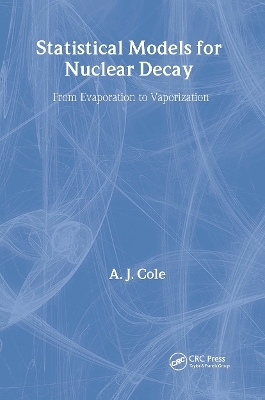
Statistical Models for Nuclear Decay
From Evaporation to Vaporization
Seiten
2000
Institute of Physics Publishing (Verlag)
9780750305129 (ISBN)
Institute of Physics Publishing (Verlag)
9780750305129 (ISBN)
- Titel z.Zt. nicht lieferbar
- Versandkostenfrei
- Auch auf Rechnung
- Artikel merken
Describes statistical models that are applied to the decay of atomic nuclei. This work presents introductions to statistical mechanics and nuclear physics, followed by a description of the historical developments, beginning with the application of the Bohr hypothesis by Weisskopf in 1937. It covers fusion, fission, and the Hauser-Festbach theory.
Statistical Models for Nuclear Decay: From Evaporation to Vaporization describes statistical models that are applied to the decay of atomic nuclei, emphasizing highly excited nuclei usually produced using heavy ion collisions. The first two chapters present essential introductions to statistical mechanics and nuclear physics, followed by a description of the historical developments, beginning with the application of the Bohr hypothesis by Weisskopf in 1937. This chapter covers fusion, fission, and the Hauser-Festbach theory. The next chapter applies the Hauser-Festbach theory using Monte Carlo methods and presents important experimental results. Subsequent chapters discuss nuclear decay at high excitation energies, including the theories and experimental results for sequential binary division, multifragmentation, and vaporization. The final chapter provides a short summary and discusses possible paths for further research.
Statistical Models for Nuclear Decay: From Evaporation to Vaporization describes statistical models that are applied to the decay of atomic nuclei, emphasizing highly excited nuclei usually produced using heavy ion collisions. The first two chapters present essential introductions to statistical mechanics and nuclear physics, followed by a description of the historical developments, beginning with the application of the Bohr hypothesis by Weisskopf in 1937. This chapter covers fusion, fission, and the Hauser-Festbach theory. The next chapter applies the Hauser-Festbach theory using Monte Carlo methods and presents important experimental results. Subsequent chapters discuss nuclear decay at high excitation energies, including the theories and experimental results for sequential binary division, multifragmentation, and vaporization. The final chapter provides a short summary and discusses possible paths for further research.
A.J Cole
Elements of equilibrium statistical mechanics. Nuclear physics background. History of statistical models of nuclear decay processes. Single and multistep evaporation calculations. Multidetectors, sequential binary decay and the characterization of multi-fragment decay processes. Statistical models for multifragmentation. Percolation, caloric curves and vaporization. From evaporation to vaporization.
| Erscheint lt. Verlag | 1.1.2000 |
|---|---|
| Reihe/Serie | Series in Fundamental and Applied Nuclear Physics |
| Verlagsort | London |
| Sprache | englisch |
| Maße | 156 x 234 mm |
| Gewicht | 748 g |
| Themenwelt | Mathematik / Informatik ► Mathematik ► Statistik |
| Naturwissenschaften ► Physik / Astronomie ► Atom- / Kern- / Molekularphysik | |
| Naturwissenschaften ► Physik / Astronomie ► Hochenergiephysik / Teilchenphysik | |
| ISBN-13 | 9780750305129 / 9780750305129 |
| Zustand | Neuware |
| Informationen gemäß Produktsicherheitsverordnung (GPSR) | |
| Haben Sie eine Frage zum Produkt? |
Mehr entdecken
aus dem Bereich
aus dem Bereich
Eine Einführung für Wirtschafts- und Sozialwissenschaftler
Buch | Softcover (2022)
De Gruyter Oldenbourg (Verlag)
CHF 41,90


